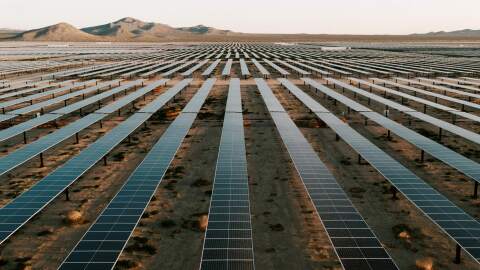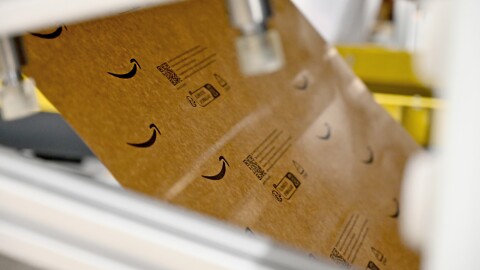Today, I am pleased to launch the findings from a new study by 451 Research, part of S&P Global Market Intelligence, revealing that moving IT workloads from on-premises data centres to the cloud would improve energy efficiency, and reduce associated carbon emissions by nearly 80% on average.[1] Commissioned by Amazon Web Services (AWS), the report surveyed 515 organizations with annual revenues between US$10 million and US$1 billion across Japan, South Korea, Singapore, Australia, and India—including over 100 Australian public sector organisations, and enterprises across a wide variety of industries.
For Australian enterprises and public sector organisations, this equates to an estimated annual carbon reduction of 3,149 metric tonnes of carbon dioxide equivalent (CO2e) per MW of enterprise data centre capacity. That’s the equivalent of greenhouse gas emissions savings from more than 650 cars driven for one year.[2]
Customers migrate workloads from on-premises data centres to AWS for many reasons, including the opportunity to tap into our global infrastructure and broadest selection of services to increase agility, drive innovation, achieve cost savings, and reduce their own energy use. Moving to AWS is also more sustainable than on-premises infrastructure, because AWS has always focused on driving energy efficiency, and continuous innovation in our data centres. 451 Research estimates that large scale cloud data centres perform the same workloads with five times greater energy efficiency than companies and public sector organisations across the Asia Pacific region.
This is because our scale allows us to achieve much higher resource utilisation and energy efficiency for the same unit of work than the typical on-premises data centre, especially since the AWS global infrastructure is built on AWS’s own custom hardware - purpose-built and optimised for workloads run by AWS customers. By designing our own equipment, we’re able to develop hardware that works at the best possible performance, and allows us to capture power efficiency gains in compute, storage, and more. For example, our custom-built AWS Graviton2 processors provide better performance per watt than any other Amazon Elastic Compute Cloud (Amazon EC2) processor. Amazon EC2 is a web service designed to make cloud computing easier for developers by offering a choice of Intel, AMD, and Arm-based processors. We also closely track resource usage to optimise utilisation, reduce energy, and increase operational excellence across our data centre equipment and infrastructure.
In our own facilities, AWS is also constantly innovating the design and application of cooling systems to reduce water use, and we use real-time sensor data to adapt to changing weather conditions. Where we can, we use reclaimed or recycled water instead of potable drinking water, working with local utilities to expand the use of reclaimed water, and we look for opportunities to return water to the community.
Taking Sustainable Innovations to the World Stage
The ability to innovate is important to customers and partners, and to help them achieve that, we provide them with access to the latest cloud technology. For example, energyOS, an Australian energy Software-as-a-Service company, developed its leading digital energy services platform, eOS, to help utility companies respond to the transition to clean and distributed energy. It replicates the energy services that were formerly the exclusive remit of large commercial and industrial customers, with targeted digital services that can be offered to residential and small-to-medium business customers on a mass-market scale. In April 2021, energyOS, made its service eOS, available on AWS Marketplace to offer the digital engagement, product support, distributed, and clean-energy capabilities demanded by their customers. This enables energyOS to extend the reach of its innovation by offering its clean energy service to customers all around the world and to deliver digital services in a rapidly evolving technical and regulatory environment. This is driving a huge amount of data for initiatives like five-minute settlement, a new industry change enabling electricity to be bought and sold in smaller increments, potentially leading to lower prices.
We are also working with Vector, one of New Zealand’s largest energy companies, to jointly develop a New Energy Platform (NEP). Powered by AWS, the NEP is an Internet of Things (IoT) and analytics solution for the energy industry, the first of its kind in Australia and New Zealand. The rise in renewable energy sources, growth in electric vehicles, and higher consumer expectations for lower prices and sustainable energy sources requires the energy industry to transform and harness the power of data to make smarter customer-centric decisions. The insights collected by the NEP helps Vector enable energy and utility companies to develop tailored product and pricing solutions for their customers based on their energy consumption habits.
Powered by AWS, the NEP is an Internet of Things (IoT) and analytics solution for the energy industry, and will be introduced first in Australia and New Zealand, where there are around 70 energy retailers and more than 40 distribution networks, to help deliver to consumers more affordable, reliable, and cleaner energy options. Through this strategic alliance, Vector and AWS will leverage the breadth and depth of AWS services, including IoT, analytics, machine learning (ML), and infrastructure services, with Vector’s energy industry knowledge, plus the joint engineering capability of both organizations.
Taking Long Term Action
Amazon is the world’s largest corporate buyer of renewable energy, supported in Australia by investment in three wind and solar projects across the country – a wind farm in Hawkesdale, Victoria, and two solar farms in regional New South Wales, one in Gunnedah and another in Suntop. When operational, our three renewable energy projects in Australia will generate 717,000 MWh of renewable energy annually, the equivalent to the annual electricity usage of almost 115,000 average Australian homes.
Globally, our investment in renewable energy forms part of our commitment to The Climate Pledge, in which we have committed to be net zero carbon across our business by 2040. We also have a target to be powered with 100% renewable energy by 2030, and we are currently on a path to achieve this by 2025. In 2020, we reached 65% renewable energy across our business, and our renewable projects will supply energy for Amazon’s corporate offices, fulfillment centres, and AWS data centres that support millions of customers globally.
Climate change is one of the most critical challenges we face. We are committed to building a sustainable business for our customers and the planet. In addition to The Climate Pledge commitment, we are also constantly investing in new low carbon technologies and the fight against climate change via the Climate Pledge Fund, Right Now Climate Fund and the most recent $1 Billion Sustainability Bond.
By investing in renewable power and ensuring our facilities and operations run efficiently, we are providing our customers with the computing power they need to solve innovative challenges, while at the same time helping them reduce overall impact on the environment, and meet their own sustainability ambitions.
[1] 451 Research surveyed 515 organizations in Asia Pacific (APAC), including over 100 in Australia, with annual revenues between US$10 million and US$1 billion, across a variety of industries including manufacturing, healthcare and financial services. Other markets covered in the study include Japan, South Korea, Singapore and India.
[2] From moving one quarter of one average company’s IT workloads to the cloud. Note in the 451 study, the mean amount of IT equipment for large enterprise and public sector organizations was 4MW. 650 cars emissions calculated using the Greenhouse Gas equivalencies calculator: https://www.epa.gov/energy/greenhouse-gas-equivalencies-calculator
Photo supplied by Canadian Solar











